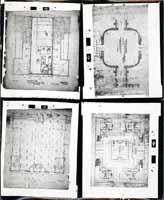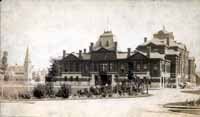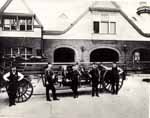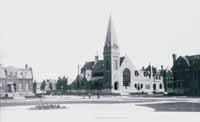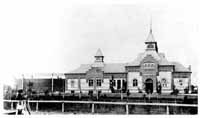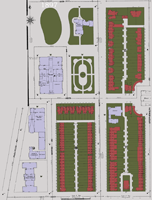The Pullman Bank
Contributed by Kate Corcoran

Interior of the Pullman Bank in the Arcade Building
Image generously donated by the Lake County Discovery Museum, Curt Teich Postcard Archives
|

Advertising postcard, mailed in 1910 from the renamed Pullman Trust and Savings Bank, president Edward F. Bryant. Bryant was made bank manager in 1886 and was with the bank until at least 1924. [From the collection of Kate Corcoran]
On the verso, sent to an address on E. 115th, a preprinted message reads "This is the bank for the 'Industries.' A working man that deposits his savings here co-operates with us to make busy workshops which means happy people in the Calumet District"
|
The Pullman Bank occupied the northeast corner of the first floor of the Arcade. The Pullman Loan and Savings Bank, incorporated in 1883, was controlled by the Pullman's Palace Car Company. Both the bank and company encouraged savings (by offering a 4% interest rate) and encouraged and offered loans for home ownership (though not in Pullman). Doty makes much of the growth in accounts and total and average deposits from the bank's inception (August 1884: 578 accounts, total deposits of $83,943, average savings per account, $146; April 1893: 2,249 accounts, total deposits of $630,889, average savings per account, $283), but neglects to mention two of the major functions of the bank: paymaster and debt (especially rent) collector.
Until 1891 (when this practice was made illegal), Pullman operatives that lived in the town would arrive to collect their pay, from which rent had already been deducted. After 1891, an operative would receive 2 checks, "one for the amount of his rent and the other for the balance of his wages. Pressure was placed on him to immediately endorse the rent check and apply it to his debt..." This practice- reported and examined during the Pullman Strike and in the subsequent United States Strike Commission Report- contributed mightily to the suffering of town-dwellers during the strike.
In at least one case, Pullman was able to absorb another company, the Pullman Iron and Steel Company, into the main Pullman's Palace Car Company because of its immense debt to the bank and to the company. In later years, the bank served as the sale and mortgage agent for land sales in Pullman.




